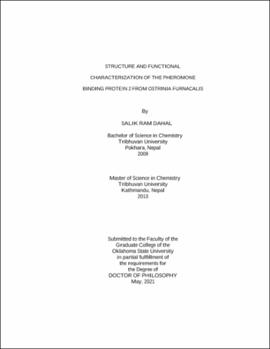| dc.contributor.advisor | Mohanty, Smita | |
| dc.contributor.author | Dahal, Salik Ram | |
| dc.date.accessioned | 2023-08-21T19:42:36Z | |
| dc.date.available | 2023-08-21T19:42:36Z | |
| dc.date.issued | 2021-05 | |
| dc.identifier.uri | https://hdl.handle.net/11244/338887 | |
| dc.description.abstract | Animal olfaction has an immense impact on their survival. The insect olfactory system is the most exquisitely sensitive in the animal kingdom. Moth antennae contain hair-like structures called sensilla, which are involved in detecting chemical signals. A male moth can detect pheromone released by the female from a far distance. The hydrophobic pheromone molecules pass through the pores of the sensillum cuticle and enter into the sensillum lymph. Pheromone-bonding protein (PBP) present in the lymph of the sensilla of the male moth antennae binds and transports the pheromone molecules through the aqueous layer to the receptors that initiate signaling, which leads to mating. PBPs bind to pheromone with high affinity at neutral pH in the open conformation and undergo a conformational switch, and release the ligand at acidic pH. Ligand release and binding occur through the concerted pH-dependent mechanism where two molecular gates (the histidine gate, His70-His95, and the C-terminal tail) play a critical role. Ostrinia furnacalis is an agricultural insect pest. The Ostrinia furnacalis pheromone binding protein 2 (OfurPBP2) has more than 50%, similarly with the well-studied PBPs including Antheraea Polyphemus pheromone binding protein1 (ApolPBP1) and Bombyx mori pheromone binding protein (BmorPBP). However, there are remarkable differences in both biological gates; a) one of the histidine-gate residues, His70, is substituted by arginine, b) the C-terminal tail has seven charged residues as compared to three. The molecular impact of these substitutions on structure and mechanism of action is unknown. Furthermore, structure and mechanistic studies of several of these proteins are needed to gain the knowledge to design inhibitors through pheromone mimetics, which constitutes a novel mechanism to control these pests. | |
| dc.description.abstract | Our work has dissected the structural details to understand the structural mechanism of pheromone binding and release in this pest. NMR investigations have shown that OfurPBP2 undergoes conformational heterogeneity at acidic pH of 4.5. We have used small-angle X-ray scattering (SAXS) to show the protein is homogeneous, well-folded, and has a compact globular shape. OfurPBP2 consists of seven helices with residues 2-14 (α1a), 16-22(α1b), 27–37 (α2), 46–60 (α3), 70–80 (α4), 84–100 (α5), 107–124(α6), and 131-143 (α7) which are arranged in a globular fold, and contains the three disulfide bridges 19-54, 50-108, and 97-117 enclosing a large hydrophobic binding pocket inside. The structure of the OfurPBP2 contains a C-terminal helix (α7) residues 131-143 extended outside the hydrophobic pocket, which is in contrast with previously studied PBPs, where they have a random coil at pH 6.5. OfurPBP2 binds the pheromones at high pH. The MD simulations were carried to identify the flexible region in the protein structure. | |
| dc.format | application/pdf | |
| dc.language | en_US | |
| dc.rights | Copyright is held by the author who has granted the Oklahoma State University Library the non-exclusive right to share this material in its institutional repository. Contact Digital Library Services at lib-dls@okstate.edu or 405-744-9161 for the permission policy on the use, reproduction or distribution of this material. | |
| dc.title | Structure and functional characterization of the pheromone binding protein 2 from Ostrinia furnacalis | |
| dc.contributor.committeeMember | Bunce, Richard | |
| dc.contributor.committeeMember | Berlin, K. Darrell | |
| dc.contributor.committeeMember | Deng, Junpeng | |
| osu.filename | Dahal_okstate_0664D_17228.pdf | |
| osu.accesstype | Open Access | |
| dc.type.genre | Dissertation | |
| dc.type.material | Text | |
| dc.subject.keywords | pheromone binding | |
| dc.subject.keywords | hydrophobic pocket | |
| dc.subject.keywords | nuclear magnetic resonance | |
| dc.subject.keywords | Ostrinia furnacalis | |
| dc.subject.keywords | pheromone-binding protein2 | |
| dc.subject.keywords | pheromones | |
| thesis.degree.discipline | Chemistry | |
| thesis.degree.grantor | Oklahoma State University | |
